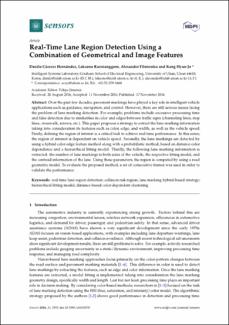El sistema se apagará debido a tareas habituales de mantenimiento. Por favor, guarde su trabajo y desconéctese.
Mostrar el registro sencillo del ítem
Real-Time Lane Region Detection Using a Combination of Geometrical and Image Features
| dc.contributor.author | Cáceres Hernández, Danilo | |
| dc.contributor.author | Filonenko, Alexander | |
| dc.contributor.author | Hyun Jo, Kang | |
| dc.contributor.author | Kurnianggoro, Laksono | |
| dc.date.accessioned | 2018-06-29T21:17:47Z | |
| dc.date.accessioned | 2018-06-29T21:17:47Z | |
| dc.date.available | 2018-06-29T21:17:47Z | |
| dc.date.available | 2018-06-29T21:17:47Z | |
| dc.date.issued | 2016-11-17 | |
| dc.date.issued | 2016-11-17 | |
| dc.identifier.issn | 1424-8220 | |
| dc.identifier.uri | http://ridda2.utp.ac.pa/handle/123456789/5090 | |
| dc.identifier.uri | http://ridda2.utp.ac.pa/handle/123456789/5090 | |
| dc.description | Over the past few decades, pavement markings have played a key role in intelligent vehicle applications such as guidance, navigation, and control. However, there are still serious issues facing the problem of lane marking detection. For example, problems include excessive processing time and false detection due to similarities in color and edges between traffic signs (channeling lines, stop lines, crosswalk, arrows, etc.). This paper proposes a strategy to extract the lane marking information taking into consideration its features such as color, edge, and width, as well as the vehicle speed. Firstly, defining the region of interest is a critical task to achieve real-time performance. In this sense, the region of interest is dependent on vehicle speed. Secondly, the lane markings are detected by using a hybrid color-edge feature method along with a probabilistic method, based on distance-color dependence and a hierarchical fitting model. Thirdly, the following lane marking information is extracted: the number of lane markings to both sides of the vehicle, the respective fitting model, and the centroid information of the lane. Using these parameters, the region is computed by using a road geometric model. To evaluate the proposed method, a set of consecutive frames was used in order to validate the performance | en_US |
| dc.description.abstract | Over the past few decades, pavement markings have played a key role in intelligent vehicle applications such as guidance, navigation, and control. However, there are still serious issues facing the problem of lane marking detection. For example, problems include excessive processing time and false detection due to similarities in color and edges between traffic signs (channeling lines, stop lines, crosswalk, arrows, etc.). This paper proposes a strategy to extract the lane marking information taking into consideration its features such as color, edge, and width, as well as the vehicle speed. Firstly, defining the region of interest is a critical task to achieve real-time performance. In this sense, the region of interest is dependent on vehicle speed. Secondly, the lane markings are detected by using a hybrid color-edge feature method along with a probabilistic method, based on distance-color dependence and a hierarchical fitting model. Thirdly, the following lane marking information is extracted: the number of lane markings to both sides of the vehicle, the respective fitting model, and the centroid information of the lane. Using these parameters, the region is computed by using a road geometric model. To evaluate the proposed method, a set of consecutive frames was used in order to validate the performance | en_US |
| dc.language | eng | |
| dc.language.iso | eng | en_US |
| dc.rights | https://creativecommons.org/licenses/by-nc-sa/4.0/ | |
| dc.rights | info:eu-repo/semantics/openAccess | |
| dc.subject | real-time lane region detection | en_US |
| dc.subject | collision risk region | en_US |
| dc.subject | lane marking hybrid-based strategy | en_US |
| dc.subject | hierarchical fitting model | en_US |
| dc.subject | distance-based color-dependent clustering | en_US |
| dc.subject | real-time lane region detection | |
| dc.subject | collision risk region | |
| dc.subject | lane marking hybrid-based strategy | |
| dc.subject | hierarchical fitting model | |
| dc.subject | distance-based color-dependent clustering | |
| dc.title | Real-Time Lane Region Detection Using a Combination of Geometrical and Image Features | en_US |
| dc.type | info:eu-repo/semantics/article | |
| dc.type | info:eu-repo/semantics/publishedVersion |
